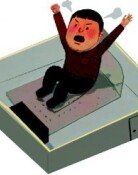Discomforting results of Seoul’s overly friendly stance towards Pyongyang
Discomforting results of Seoul’s overly friendly stance towards Pyongyang
Posted July. 27, 2019 07:20,
Updated July. 27, 2019 07:20
North Korea’s Korean Central News Agency filed a report on Pyongyang’s launch of ballistic missiles on Friday, saying, “National Defense Commission Chairman Kim Jong Un stated the launch was part of our military demonstrations meant to send a stern warning (to South Korea).” The report included the expression “warning” as many as three times. The act of Pyongyang calling “the latest launch,” “military demonstration” this time after labeling its missile test in May as a “live fire drill plan” apparently constitutes its threat against Seoul. North Korean leader Kim Jong Un’s statement, which says South Korean authorities’ gesturing “handshaking of peace” while showing off documents such as a joint declaration in one hand, but doing something strange in the other,” is just a direct verbal attack on South Korean President Moon Jae-in.
The North’s clarifying that its missile launch is a countermeasure against the South Korea-U.S. joint drills known as “Alliance 19-2,” which is scheduled next month, and the South’s introduction of stealth fighters is a ridiculous accusation. Large scale South Korea-U.S. joint military drills have been halted since last year. The joint military drill, which is being conducted at a much smaller scale from this year, is a command-post drill that is focused on computer simulations, and the North’s demand to halt the drill is an absurd attempt to block it. The introduction of stealth fighters by the South is a measure that a sovereign country can and should do to beef up its defense capabilities. The North’s provocation is a typical brinkmanship strategy that is aimed at increasing pressure on Washington by swaying Seoul, without bothering Washington ahead of their bilateral working-level talks for Pyongyang’s denuclearization.
In an interview with Fox News of the U.S. last year, President Moon Jae-in said, “The military drills that have been suspended can be resumed at any time depending on the North’s behaviors.” However, a joint military drill is not something that can be resumed overnight. It requires thorough preparations including the development of operation plans, transportation of military personnel, and deployment of military supplies, which can take months. No matter how advanced weapons South Korea possesses, they can become useless if they are buttressed by the military’s capability to operate them and systematically mobilize troops through continuous military drills. Critics say the Seoul government, which is apparently aware of this situation, pledged to change the names of the drills after halting large-scale joint exercises by being overly friendly towards Pyongyang, which in turn has effectively enabled North Korean leader Kim Jong Un to threaten the South.
In the wake of the North’s missile provocations, Pyongyang’s nuclear and missile threats have entered a new phase. The North Korean version of the Iskander, a new short-range missile, cruises at a low altitude of 50 kilometers or less, making it difficult to detect and intercept. Notably, the South Korean military authority failed in detecting, tracking and forecasting the impacted area of the missiles, and thus had to change its estimates of flying distances of the two missiles over a two-day period. If this happens in a real situation, even the advanced Terminal High Altitude Area Defense (THAAD) and the Patriot PAC-3 missile, which are possessed by the U.S. and South Korea, will not be able to intercept the North Korean missile. If and when the North Korean missile is put to combat mission, its striking range will include the entire South Korean territory, only excluding Jeju Island. The South Korean military authority should prepare countermeasures to be able to cope with a situation where its existing missile defense systems get incapacitated.







